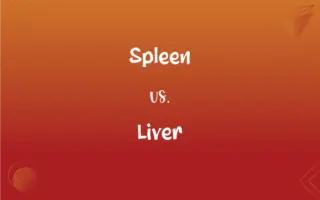Cold Blooded Animals vs. Warm Blooded Animals: What's the Difference?
Edited by Janet White || By Harlon Moss || Updated on October 7, 2023
Cold-blooded animals have body temperatures varying with the environment; warm-blooded animals maintain a constant internal temperature.

Key Differences
Cold-blooded animals, also termed ectothermic, directly align their body temperature with their external environment. In contrast, warm-blooded animals, known as endothermic, preserve a stable internal body temperature, irrespective of external conditions.
The behavior of cold-blooded animals often adapts to manage their body temperature, like basking in the sun to gain heat. Conversely, warm-blooded animals utilize internal mechanisms, like metabolism or shivering, to generate and maintain heat internally.
Cold-blooded creatures tend to be more energy-efficient, using less food and energy for metabolic processes. Warm-blooded entities, however, expend more energy maintaining their body temperature, demanding frequent nourishment to fuel these processes.
In cold environments, cold-blooded animals may experience lowered metabolism and activity. However, warm-blooded animals remain agile and active, as their internal systems generate necessary heat, even in chilly conditions.
The habitats of cold-blooded animals are often restricted by climatic conditions due to their temperature dependency. Warm-blooded animals, in turn, exhibit broad geographical ranges and varied habitats since they can regulate their internal temperature.
ADVERTISEMENT
Comparison Chart
Body Temperature
Varies with environment.
Remains constant.
Energy Efficiency
Typically more energy-efficient.
Require more energy for temperature regulation.
Activity in Cold Weather
May become lethargic or inactive.
Remain active and alert.
Metabolic Rate
Can be influenced significantly by external temperatures.
Relatively constant and higher.
Habitat Diversity
Often limited by climate conditions.
Can inhabit diverse climates and altitudes.
ADVERTISEMENT
Cold Blooded Animals and Warm Blooded Animals Definitions
Cold Blooded Animals
Species whose enzymatic and physiological functions are temperature-dependent.
Insects, being cold-blooded, might experience reduced activity during cooler weather.
Warm Blooded Animals
Animals maintaining a consistent internal body temperature.
Humans are warm-blooded, maintaining a body temperature around 98.6°F.
Cold Blooded Animals
Animals that cannot regulate their body temperature internally.
Reptiles, like snakes, are examples of cold-blooded animals.
Warm Blooded Animals
Organisms regulating body heat through metabolic processes.
Birds, being warm-blooded, can endure cold climates by generating internal heat.
Cold Blooded Animals
Animals relying on external sources to manage their temperature.
Fish, as cold-blooded animals, are subject to the temperature of their aquatic environments.
Warm Blooded Animals
Creatures that can be active in varied thermal conditions.
Mammals, as warm-blooded animals, can be found in both polar and desert environments.
Cold Blooded Animals
Organisms with a body temperature that mirrors the environment.
Frogs, being cold-blooded, will seek sunlight to warm up.
Warm Blooded Animals
Animals consuming more food to sustain stable internal heat.
Dogs, being warm-blooded, require a consistent diet to support their metabolic heat production.
Cold Blooded Animals
Creatures that physically adapt behavior to regulate body heat.
Lizards, as cold-blooded animals, often bask on rocks to increase their body temperature.
Warm Blooded Animals
Species possessing mechanisms to manage internal thermal stability.
Whales, despite living in some cold ocean regions, maintain a warm and stable internal temperature being warm-blooded.
FAQs
Can cold-blooded animals survive in extreme cold environments?
Cold-blooded animals may struggle in extremely cold environments due to reduced metabolic function and activity.
What allows warm-blooded animals to inhabit various climates?
Their ability to regulate internal body temperature enables warm-blooded animals to live in diverse climates.
How do warm-blooded animals regulate their internal temperature?
Through metabolic processes, warm-blooded animals generate heat to maintain a constant internal temperature.
Can you provide an example of a warm-blooded animal?
Humans are an example of warm-blooded animals.
What challenges do cold-blooded animals face in temperature regulation?
Cold-blooded animals might face decreased mobility and metabolic issues in cold environments due to their dependency on external heat sources.
What is a primary characteristic of cold-blooded animals?
Cold-blooded animals have body temperatures that fluctuate with their environment.
How do warm-blooded animals adapt to colder environments?
Warm-blooded animals adapt by utilizing metabolic heat generation and sometimes developing insulating mechanisms like fat or fur.
How do cold-blooded animals respond to high temperatures?
Some cold-blooded animals may become more active with increased metabolism in higher temperatures, while others seek shade to avoid overheating.
How do warm-blooded animals deal with overheating?
Warm-blooded animals employ mechanisms like sweating, panting, or utilizing shade to manage overheating.
What is an example of a cold-blooded animal?
Snakes are a typical example of cold-blooded animals.
Do warm-blooded animals have advantages in terms of survival and adaptation?
In certain aspects, yes. The capacity to regulate body temperature internally can offer survival advantages in varied and extreme environments for warm-blooded animals.
Do warm-blooded animals maintain a consistent body temperature?
Yes, warm-blooded animals regulate and maintain a stable internal body temperature.
How do warm-blooded animals deal with varying external temperatures?
Warm-blooded animals may acclimatize through physiological and/or behavioral adaptations, like shedding fur or altering activity levels.
Do cold-blooded animals grow slower than warm-blooded ones?
Growth rates can vary, but cold-blooded animals might experience slowed growth in lower temperatures due to reduced metabolic rates.
What enables warm-blooded animals to be active predators?
The ability to generate internal heat and maintain an active metabolism enables warm-blooded animals to be effective predators in various conditions.
Do cold-blooded animals have a higher fitness cost in fluctuating environments?
Potentially, as drastic temperature changes can significantly impact the metabolic and physical functioning of cold-blooded animals.
Do cold-blooded animals require less energy than warm-blooded animals?
Generally, yes. Cold-blooded animals typically require less energy and food because they do not use energy to regulate their body temperature.
Are warm-blooded animals always active regardless of the weather?
Not always, but warm-blooded animals have the capacity to remain active in varied weather due to internal temperature regulation.
Is the skin of cold-blooded animals different from that of warm-blooded ones?
Yes, skin type can vary widely, with some cold-blooded animals having scales (e.g., reptiles) and warm-blooded ones having fur or smooth skin.
Do cold-blooded animals hibernate?
Some cold-blooded animals undergo a form of hibernation, or brumation, to survive through cold periods with reduced metabolic function.
About Author
Written by
Harlon MossHarlon is a seasoned quality moderator and accomplished content writer for Difference Wiki. An alumnus of the prestigious University of California, he earned his degree in Computer Science. Leveraging his academic background, Harlon brings a meticulous and informed perspective to his work, ensuring content accuracy and excellence.
Edited by
Janet WhiteJanet White has been an esteemed writer and blogger for Difference Wiki. Holding a Master's degree in Science and Medical Journalism from the prestigious Boston University, she has consistently demonstrated her expertise and passion for her field. When she's not immersed in her work, Janet relishes her time exercising, delving into a good book, and cherishing moments with friends and family.




































































